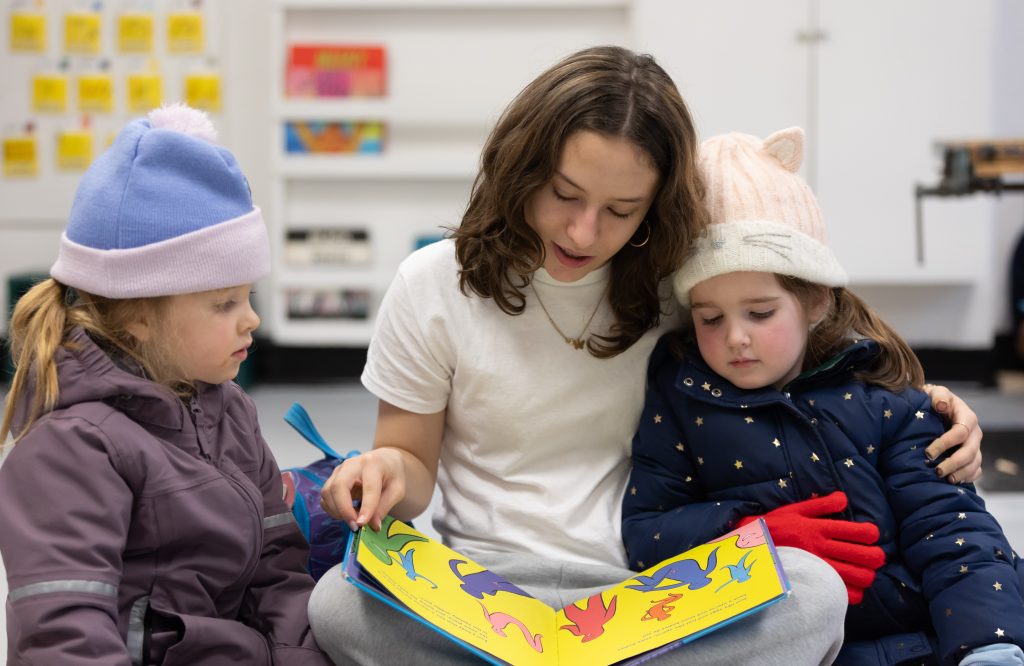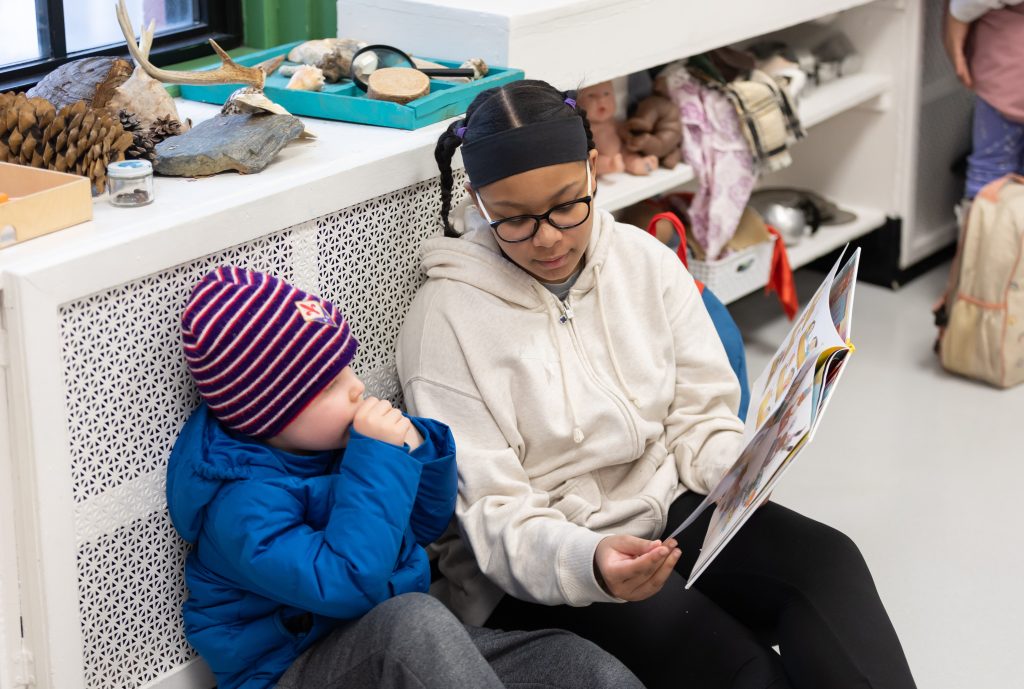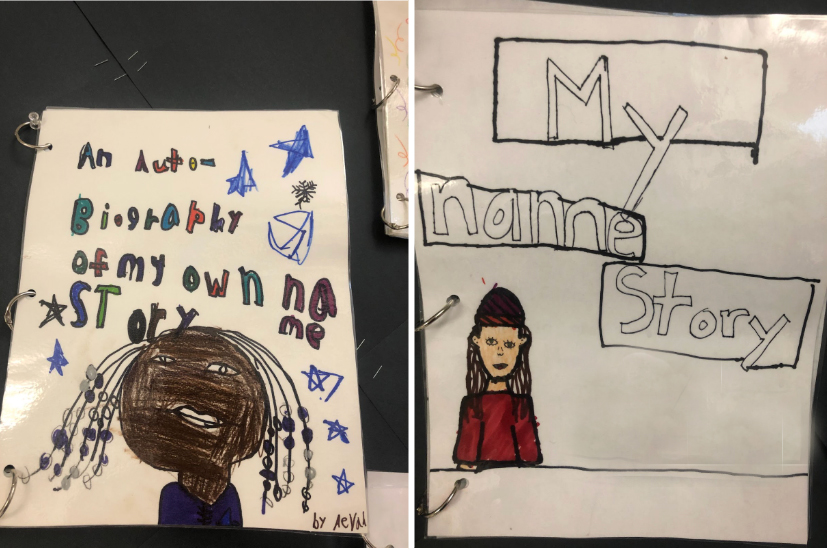The Art of Literacy, Learning, and Language
by Jane Clarke, Lower School Division Director
My last article focused on math. This one hopes to illuminate the ways in which we nurture children to become confident, critical, and joyful readers throughout the Lower School. In short, how do our children grow as readers here:

We are proud of a program that we believe meets children exactly where they are in their journey to becoming those enthusiastic, independent readers. Our Lower School program is designed specifically to build skills consistently and thoughtfully making sure we are always carefully attuned to the needs of each individual child at each different age level.
Let’s begin by looking at the IIs- IVs and then move into the Vs-VIIs.
IIs and IIIs
The IIs and IIIs read books together every day! At this point, the children are following the storyline of a book that may have already been read to them. They look closely at the illustrations and often remember the words of the story. Some IIIs may also be recognizing words and letters on the pages.
IIIs
IIIs learn that books contain information that can help them in their block-building work, and begin to explore making their own books. Sometimes, they inspired by books that parents make! IIIs also start to dictate letters to friends and family members.
IVs


In any IVs group, a familiar sight is the beloved XIIs, always up to read a book. The XIIs will write and illustrate books for the IVs by the end of the school year. Those books are cherished and read a hundred times until the IVs have memorized all the words!
Below is an excerpt from one of the archival XIIs books created for the IVs.
IVs become intrigued by the print they see in the classroom; they begin to identify letters and words in the context of their school life. They begin to ‘write’ and receive notes and letters from people they care about (notes from caregivers in their lunch boxes are particularly exciting and reassuring!)
IVs make “home-school connections” through their telling of family stories which are compiled into beloved group books that become part of the classroom collection. IVs delight in repeatedly reading and recalling their own stories and those of their friends.
Vs
Vs begin a more formal instructional Language Arts time. Here Vs are shown practicing handwriting, starting with upper case, through the Handwriting Without Tears program. As letters of the alphabet solidify, the sounds these letters make are practiced through The Sounds in Motion program (each letter makes a particular sound and is accompanied by a movement), as well as lists of words that start with each letter as it is being practiced. Games are also played in small groups to solidify phonemic awareness; the sounds of letters become a fun and interactive activity where our children learn from each other. Familiar stories are dramatized giving children an opportunity to take on different character roles. Improvising stories is a wonderful experience in developing oral language and exercising story recall.
Each year the Vs take part in a screening with Margaret Laudani, Lower School Learning Specialist. The screening provides us with important information about who your child is as a learner and a member of a group. The Learning Specialist shares the findings with Vs teachers and then with each Vs family through individual appointments.
As Vs become confident in the sound letters of the alphabet make, they begin writing their own stories. Where better place to start than with your family?
Recording information (pictures and words) on trips is another important way that Vs make connections between recording details and seeing a reason to write: so you can easily recall relevant information when you return to school and begin to plan your block-building work.
VIs
We know that children learn to read in different ways and at a different pace. The Learning Specialist and VIs teachers informally assess the children in the fall, and leveled group reading instruction begins in the VIs five times a week. In these small groups (between 4 and 5 children in each group), children receive individual attention covering phonics, sight words, and comprehension as they read “just right” books independently and with their reading teacher.
Children in the VIs and VIIs continue to play games in their small reading groups to practice and absorb better the sounds that letters make and the “word families” that exist. “If I can read ‘cat,’ then I can also read ‘mat,'” for example.
VIs take pride in their book bags. Book titles are replenished as teachers guide children into identifying “just right” books for them to read. Children are supported in all ways to feel excited about their developing reading skills.
Children begin to learn weekly sight words and start recognizing the patterns in words. VIs begin to write and illustrate their stories more confidently and skillfully. We focus on real-life events in the VIs, starting with the breakdown of a good story, beginning, middle, and end.
An exciting moment for the VIs is when they receive their very own personalized dictionaries. Children are still encouraged to sound spell words in their stories and are offered a specific number of “dictionary spelled” words each week. We are careful not to inhibit the flow of words on the page but also want to build the children’s awareness of dictionary spelling.
We also remember to acknowledge that many of us speak (and may write) different languages.
VIs begin connecting with their school library and the neighborhood Jefferson Market Library. Sometimes, they even build and open their own library! Here, a VI is independently browsing library bookshelves. As part of the trip, they will get their own public library card and can check out a book.
VIIs
Small, leveled reading groups continue into the VIIs, with children receiving the necessary and personalized instruction. Other exciting things begin to happen: in January, we introduce reading logs and ask VIIs to read independently for 20 minutes four times a week and, at the end of the week, to record the books they have read. As different genres of high-quality children’s literature begin to “prime the pump for writing,” children’s imagination begins to soar. The timeless Important Book, by Margaret Wise Brown is the inspiration for this VIIs writing piece.
Classroom book collections get organized according to genre to prime the pump for research and poetic writing. VIIs begin to use books for more formal “research” as they become more independent readers.

In the VIIs, children will also write and publish books about themselves, their first written and illustrated autobiography. In January of the VIIs program, each small reading group will go to the Library weekly for independent reading time. Guided by librarians and teachers, the VIIs are introduced to the different sections of the library and how to choose a “just right book” from the collection. They will begin this new phase in their literacy journey as they settle into library chairs and immerse themselves in reading for pleasure. Librarians and teachers continue to monitor comprehension during this time in our main library. Going to the Library to read marks a milestone for the VIIs – a C&C “rite of passage” beginning the movement towards preparing for Middle School. VIIs begin to build social relationships with Sarah Webb and Todd Rosenthal, our Librarians and Colette Corry, Middle School Learning Specialist who also teaches a VIIs Language Arts group and will follow children into the VIIIs.
Parents continue to be our partners in this journey. As VIIs become independent readers, they need to know you will still read to them. Emotionally, that bond will always be important. They also need to see you read independently from your own books! This role modeling will continue to be an inspiration for them. Your support and input are important as your children become engaged and critical independent readers. Parents are partners in this exciting part of your child’s development.
Please find here a link to how this description of our Lower School Language Arts program connects to our School’s Mission statement.
